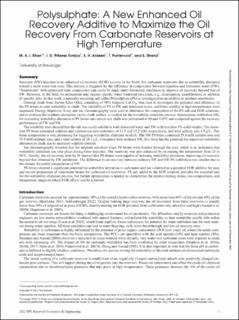| dc.contributor.author | Khan, Md Ashraful Islam | |
| dc.contributor.author | Piñerez Torrijos, Iván Darío | |
| dc.contributor.author | Aldeen, Saja H. | |
| dc.contributor.author | Puntervold, Tina | |
| dc.contributor.author | Strand, Skule | |
| dc.date.accessioned | 2023-04-04T10:29:57Z | |
| dc.date.available | 2023-04-04T10:29:57Z | |
| dc.date.created | 2022-12-22T10:01:01Z | |
| dc.date.issued | 2022 | |
| dc.identifier.citation | Khan, M. A. I., Piñerez Torrijos, I. D., Aldeen, S. H., Puntervold, T., & Strand, S. (2022). Polysulphate: A New Enhanced Oil Recovery Additive to Maximize the Oil Recovery From Carbonate Reservoirs at High Temperature. SPE Reservoir Evaluation & Engineering, 1-15. | en_US |
| dc.identifier.issn | 1094-6470 | |
| dc.identifier.uri | https://hdl.handle.net/11250/3062045 | |
| dc.description.abstract | Seawater (SW) injection is an enhanced oil recovery (EOR) success in the North Sea carbonate reservoirs due to wettability alteration toward a more water-wet state. This process is triggered by the difference in composition between injection and formation water (FW). “Smartwater” with optimized ionic composition can easily be made under laboratory conditions to improve oil recovery beyond that of SW. However, in the field, its preparation may require specific water treatment processes, e.g., desalination, nanofiltration, or addition of specific salts. In this work, a naturally occurring salt called Polysulphate (PS) is investigated as an additive to produce smartwater.
Outcrop chalk from Stevns Klint (SK), consisting of 98% biogenic CaCO3, was used to investigate the potential and efficiency of the PS brines to alter wettability in chalk. The solubility of PS in SW and deionized water, and brine stability at high temperatures were measured. Energy dispersive X-ray and ion chromatography were used to determine the composition of the PS salt and EOR solutions, and to evaluate the sulphate adsorption on the chalk surface, a catalyst for the wettability alteration process. Spontaneous imbibition (SI), for evaluating wettability alteration of PS brines into mixed-wet chalk was performed at 90 and 110°C and compared against the recovery performance of FW and SW.
The solubility tests showed that the salt was easily soluble in both deionized water and SW with less than 5% solid residue. The deionized PS brine contained sulphate and calcium ion concentrations of 31.5 and 15.2 mM, respectively, and total salinity was 4.9 g/L. This brine composition is very promising for triggering wettability alteration in chalk. The SW PS brine contained 29.6 mM calcium ions and 55.9 mM sulphate ions, and a total salinity of 38.1 g/L. Compared with ordinary SW, this brine has the potential for improved wettability alteration in chalk due to increased sulphate content.
Ion chromatography revealed that the sulphate adsorbed when PS brines were flooded through the core, which is an indication that wettability alteration can take place during brine injection. The reactivity was also enhanced by increasing the temperature from 25 to 90°C. Finally, the oil recovery tests by SI showed that PS brines were capable of inducing wettability alteration, improving oil recovery beyond that obtained by FW imbibition. The difference in oil recovery between ordinary SW and SW PS imbibition was smaller due to the already favorable composition of SW.
PS brines showed a significant potential for wettability alteration in carbonates and are validated as a potential EOR additive for easy and on-site preparation of smartwater brines for carbonate oil reservoirs. PS salt, added to the EOR solution, provides the essential ions for the wettability alteration process, but further optimization is needed to characterize the optimal mixing ratios, ion compositions, and temperature ranges at which EOR effects can be achieved. | en_US |
| dc.language.iso | eng | en_US |
| dc.publisher | Society of Petroleum Engineers | en_US |
| dc.rights | Navngivelse 4.0 Internasjonal | * |
| dc.rights.uri | http://creativecommons.org/licenses/by/4.0/deed.no | * |
| dc.title | Polysulphate: A New Enhanced Oil Recovery Additive to Maximize the Oil Recovery From Carbonate Reservoirs at High Temperature | en_US |
| dc.type | Peer reviewed | en_US |
| dc.type | Journal article | en_US |
| dc.description.version | publishedVersion | en_US |
| dc.rights.holder | The authors | en_US |
| dc.subject.nsi | VDP::Teknologi: 500 | en_US |
| dc.source.pagenumber | 15 | en_US |
| dc.source.journal | SPE Reservoir Evaluation and Engineering | en_US |
| dc.identifier.doi | 10.2118/211443-PA | |
| dc.identifier.cristin | 2096789 | |
| cristin.ispublished | true | |
| cristin.fulltext | original | |
| cristin.qualitycode | 2 | |

